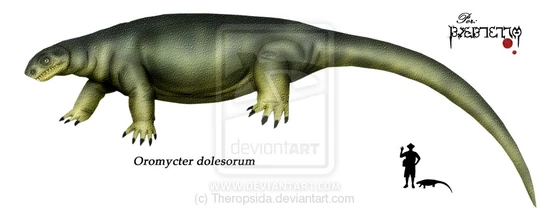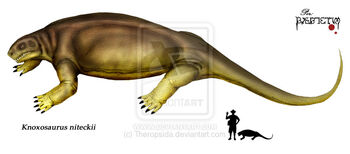
Knoxosaurus niteckii, a caseid pelycosaur.
Caseidae (assigned to Pelycosauria by Williston, 1912) were a widespread group of very primitive herbivorous synapsids, which appeared during the later early Permian and persisted until the late middle Permian. Although ranging in size from 1 to 5½ meters (3–18 feet) in body length, caseids were surprisingly conservative in their skeletal anatomy and body proportions. All were large animals with small heads and barrel-like bodies. Some, like Angelosaurus and Cotylorhynchus, which exceeded 4 meters long and were the largest of the pelycosaurs, seemed to have played the same ecological role during the later part of the early Permian that the pareiasaurs and herbivorous dinocephalians did during the Middle and Late Permian. The caseid skull is distinctive in the presence of large temporal openings, enormous external nares (probably to house some kind of sensory or moisture-conserving organ), and large pineal opening, and a snout or upper jaw that dramatically overhangs the tooth row to form a forward projecting rostrum. The external surface of the skull is sculpted with rounded deep pits and sometimes crevice-like depressions. The marginal teeth are quite similar to the teeth of pareiasaurs. In contrast to most other synapsids, except edaphosaurids, and as befits the herbivorous lifestyle, the teeth are remarkably uniform. There is a general reduction in the number of marginal teeth and cheek teeth. All caseids, whether modest or enormous, are characterized by small cervical vertebrae, bulky, barrel-shaped bodies and relatively massive limbs.
Genus[]
Phreatophasma[]
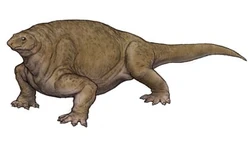
Phreatophasma aenigmaticum.
Phreatophasma aenigmaticum (named by Efremov, 1954 and assigned to Caseidae by R. L. Carroll, 1988) is a caseid pelycosaur from the Upper Permian (Kazanian stage) found only at Santagulov Mine (Permian of Russian Federation). It remains one single isolated femur.
Oromycter[]
Angelosaurus[]
Angelosaurus ("meaning angel lizard") is known from a partial skull from the Middle San Angelo Formation, Knox County, Texas, USA. It dates from the Kungurian (Early Permian). It was from three to three and a half metres long and weighed about 300 kilograms. It belongs to the family Caseidae. Like its contemporary, another caseid, Cotylorhynchus, it was large, heavily built, and herbivorous. It also shared its environment with the caseids Caseoides and Caseopsis. It may have been preyed upon by the large sphenacodont pelycosaur Dimetrodon. Like all caseids, Angelosaurus was an evolutionarily conservative reptile which would appear to have been one of the dominant herbivores of the time, occupying a similar ecological role to cows. Caseid skulls are distinguished from other pelycosaurs by large temporal openings, large nasal and pineal openings and an upper jaw that distinctively overhangs the teeth of the lower jaw.The skull is pitted. The teeth are uniform. The body was probably barrel-shaped, like other caseids, with massive limbs and small cervical vertebrae. And unlike the more well-known pelycosaurs such as Dimetrodon and Edaphosaurus, caseids do not have the exaggerated elongation of the vertebrae that form a sail. Three species of Angelosaurus have been described: Angelosaurus greeni Olson 1962, Olson & Berrbower 1953 Olson & Berrbower 1953, and Angelosaurus romeri Olson and Barghusen, 1962.
Species[]
Casea[]
Casea is an extinct genus of pelycosaur synapsid which was about 1.2 metres (4 ft) long, slightly smaller than the otherwise very similar Caseoides. Casea was one of the first terrestrial herbivores, sharing its world with animals such as Dimetrodon and Eryops.
Description[]
Casea had a heavy, rotund, body and a small skull. Its rib cage was greatly expanded, presumably to make space for a large, plant-fermening gut. Like other caseids, it lacked teeth in its lower jaw, and had blunt teeth in the upper jaw. These adaptations indicate that Casea was a herbivore, feeding on relatively tough plants, such as ferns.
Gallery[]
Caseopsis[]
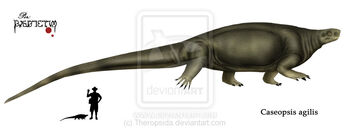
Caseopsis agilis.
Caseopsis agilis was a large pelycosaur that was about 3 meters long, it lived in the late Early Permian epoch (Kungurian Age), before the pelycosaurs were replaced by the more advanced therapsids (in the next age). It was a lightly built, agile creature. It may have been possible for this species to outpace and escape large predators such as Dimetrodon.
Caseoides[]

Caseoides sanangelensis.
Caseoides sanangelensis (named by Olson and Berrbower, 1953) was a large caseid that lived in the Kungurian Age (late Early Permian epoch). It was about 3 meters long, and like many other caseids, it was herbivorous. It weighed between 150 kg to 200 kg. Its fossils were found on Texas. Caseoides sanangelensis was very similar to Casea, but was slightly larger in size. Caseoides agilis was heavily built creature, as most of Caseids (except Caseopsis). In the development of its proportionally thick, stout limbs it represents the culmination of the Casea lineage. Its relatives became smaller in size during the Roadian Age (after Kungurian).
Ennatosaurus[]
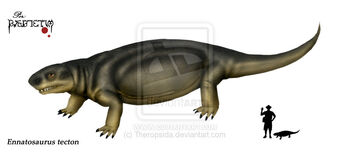
Ennatosaurus tecton.
Ennatosaurus (meaning "the 9th lizard", named by Efemov, 1956) was a caseid that lived in Russia during the Wordian stage of the Permian period, it was herbivorous, possibly using its broad forefeet to dig at plants. Like all caseids, Ennatosaurus tecton had a small head compared to its wide, lizard-like body. Its mouth was lined with blunt, peg-like teeth. It lived alongside other Permian creatures, such as the herbivorous Nyctiphruretus and the carnivorous Biarmosuchus. The adult size for Ennatosaurus tecton is unknown, fossil remains show an animal about the size of a cat, but these are likely juvenile specimens, the adults growing to sizes that may have rivaled those of 20-foot (6.1 m)-long cousin, Cotylorhynchus. Ennatosaurus tecton is known from only one fossil site, where several juveniles were buried simultaneously in sand. One adult skull was found among the juvenile skeletons.
Euromycter[]

Euromycter rutenus.
Euromycter ("European Nose" Sigogneau-Russell & Russell, 1974) is a large caseid from middle Early to early Late Permian (upper Sakmarian to lower Lopingian) deposits of Southern France. It is known from the holotype MNHN.F.MCL-2, complete skull with lower jaws and partial postcranial skeleton. It was collected by D. Sigogneau-Russell and D. Russell in the 1970s from the base of the M1 Member, Grès Rouge Group, near the town of Valady (département of Aveyron), Rodez Basin. It was first assigned to the species "Casea" rutena by Sigogneau-Russell and Russell, 1974. More recently, it was reassigned to its own genus Euromycter. Euromycter was first named by Robert R. Reisz, Hillary C. Maddin, Jörg Fröbisch and Jocelyn Falconnet in 2011 and the type species is Euromycter rutenus.
Ruthenosaurus[]
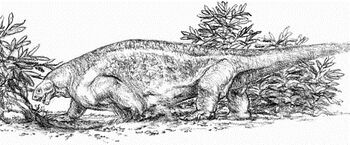
Ruthenosaurus russellorum.
Ruthenosaurus russellorum is an extinct genus of large caseid from middle Early to early Late Permian (upper Sakmarian to lower Lopingian) deposits of Southern France. It is known from the holotype MNHN.F.MCL-1 a partial postcranial skeleton. It was collected by D. Sigogneau-Russell and D. Russell in the 1970’s from the base of the Grès Rouge Group, near the town of Valady (departement of Aveyron), Rodez Basin. It was first named by Robert R. Reisz, Hillary C. Maddin, Jörg Fröbisch and Jocelyn Falconnet in 2011..
Cotylorhynchus[]
Cotylorhynchus was a very large caseid that lived in the southern part of what is now North America during the Early Permian period and persisted until the late-Mid Permian (about 265 mya). Cotylorhynchus are the most well known caseid. The Cotylorhynchus were the largest pelycosaurs, the largest terrestrial vertebrates of their time, as well as the terrestrial vertebrates up to that time. They were herbivores, and because of their enormous size they probably did not fear any of the carnivores.
Description[]
Cotylorhynchus was a massively built animal with a disproportionately small head and a huge barrel-shaped body. They could grow to lengths of up to 20 feet and could achieve weights of up to 2 tons. Their skeletal features included a massive scapulocoracoid, humeri with large flared ends, stout forearm bones and broad, robust hands that had large claws. Certain features of their hands indicate that they had to dig considerably to obtain their food supply and also they may have used these features to dig burrows for shelter or safety. Their digits were believed to have a considerable range of motion and large retractor processes on the ventral surfaces of the unguals allowed them to flex their claws with powerful motions. Also, the articulatory surfaces of their phalanges were oblique to the bone's long axis rather than perpendicular to it. This allowed for much more surface area for the flexor muscles. Their skulls are distinctive in the presence of large temporal openings and very large nostril openings, which could have been utilized for better breathing or may have housed some sort of sensory or moisture conserving organ. Also they featured large pineal openings and a snout or upper jaw that overhangs the row of teeth to form a projecting rostrum. Rounded deep pits and possibly large depressions were present on the outer surface of the skull. Their teeth were very similar to those of iguanas with posterior marginal teeth that bore a longitudinal row of cusps.
Discovery[]
Cotylorhynchus were considered a part of the first wave of amniote diversity. There have been three species of Cotylorhynchus discovered: C. hancocki, C. romeri and C. bransoni. C. hancocki is believed to be a descendent of the slightly smaller C. romeri. Various skeletal parts of C. romeri have been found around central Oklahoma in parts of Cleveland County. Parts of C. hancocki have been found in northern Texas in Hardeman and Knox counties. C. bransoni specimens have been uncovered in Kingfisher and Blaine Counties of central-northwest Oklahoma.
